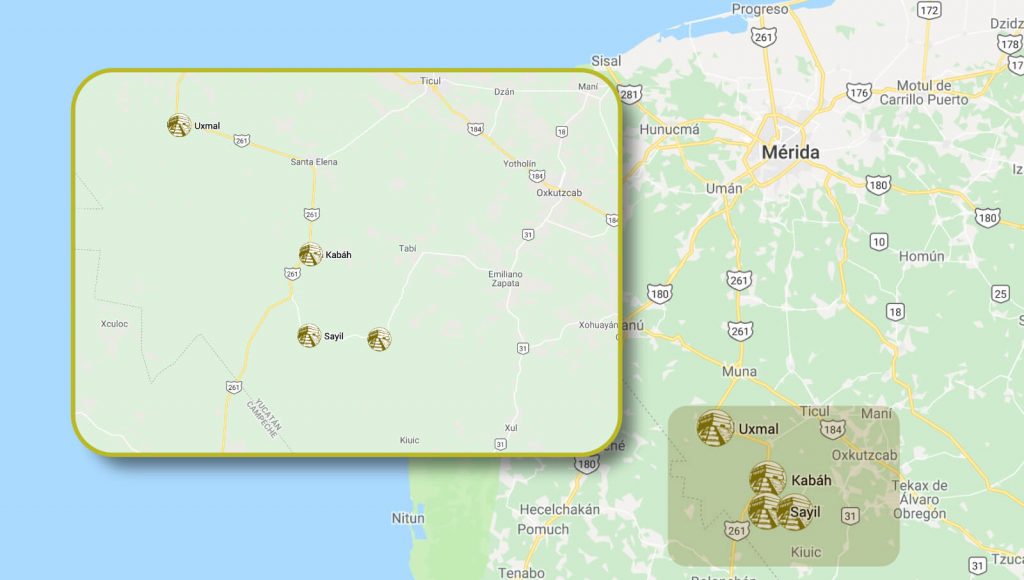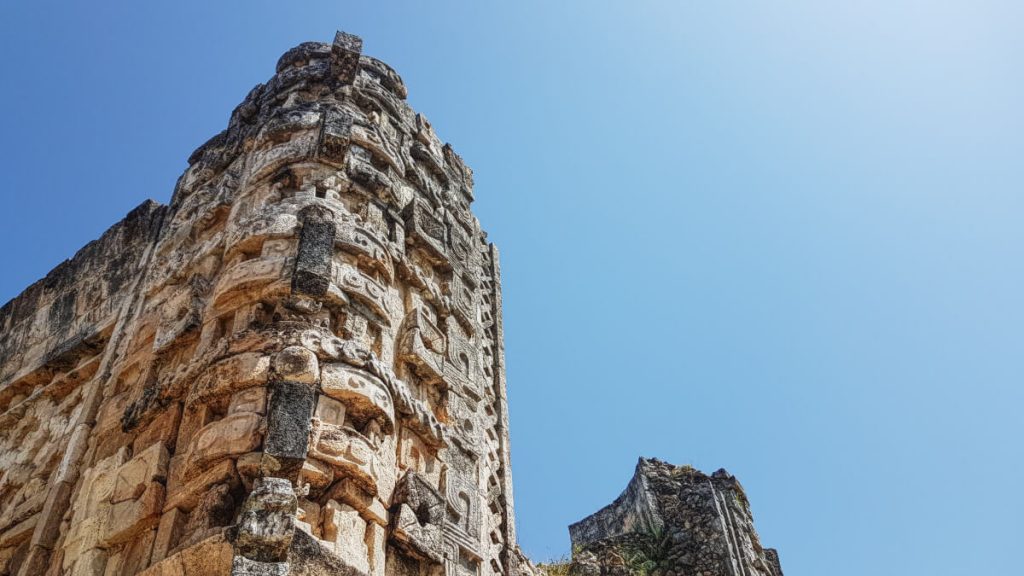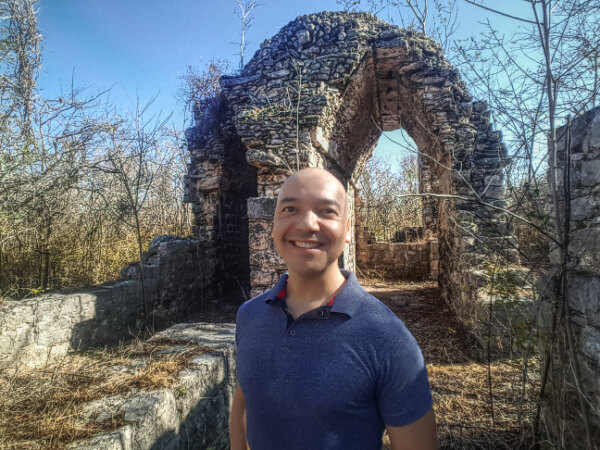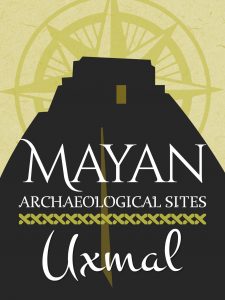The Puuc Route is a set of Mayan cities that are located near each other and share an architectural style, known as Puuc Style.

Although many sites like Chichén Itzá have some influence from the Puuc Route or Puuc Style, the most representative are Uxmal, Kabáh, Sayil, and Labná. These remaining cities stand out for their beauty and magnificence.
The word Puuc means “Sierra” or “mountain range of low hills” in the Mayan language.
The Puuc Route is considered a Mayan treasure in the south of the state of Yucatan because of the great stonework found in this area.
Puuc Region
The Puuc region is an area of small hills without rivers, a few cenotes, and with a good portion of fertile land. This region covers an area of 4,687 miles in the south-east of Yucatan and north-west of Campeche.

These limits do not correspond to the limits of the Puuc Style since there are samples of this style in other places of the Mayan Peninsula.
The Puuc style is one of the five styles of Mayan architecture, the others being: Maya Tolteca, Chenes, Río Bec, and Costa Oriental.
Puuc architecture
There are pieces of evidence that early settlers were living in the Mayan Peninsula centuries before our era, but towards the Late Classical Period (550 – 850) is when the Mayans started to build their cities using the architectural style that today it is known as Puuc.
This style brings together elements from other eras, which are mixed with original features and from the environment itself.
Characteristics of Puuc Architecture
- Smooth vertical walls at the bottom.
- Friezes that decorate the upper part, topped by flat cornices and frets.
- Columns to separate spaces and access doors, as well as stairways
Oval and truncated triangle vaults. - The buildings are decorated with masks, many of them representing Chaac, the Mayan god of rain, with its large and characteristic nose.
- Little columns, that evoke the reeds of the walls of the huts.
- Representations of wavy serpents.
- Panels with hieroglyphs and high crests.
- In Campeche, there’s more use of vertical walls topped with friezes, columns in entrances, and stair-like arches. The raw buildings are covered with well-cut stones and decorated with stone mosaics and hieroglyphics.
- In Yucatan, the vertical walls are topped with much more ornate friezes and the ornamentation becomes more abstract.
Beyond the impressive decorative elements of this architectural style, the use of a concrete base is considered an advance over the techniques that were used until then.
The use of masonry with stone veneer cover, allowed the construction to remain standing for a longer time, even though much of the construction has collapsed, some stone covers are still standing.

The presence of the huge number of masks dedicated to the rain god Chaac is explained by their dependence on rain. Mainly because the Mayans living in the Puuc route didn’t have other sources of water like rivers and lakes.
An important thing to keep in mind is that the Puuc route doesn’t only focus on architectural constructions, but it’s also found in the art such as painting and ceramics. Even the crests and buildings were painted in bright colors.
Important cities of the Puuc Route
Although there are some relevant cities, such as Chichén Itzá or Edzná, which also have elements of the Puuc architectural style, there is a group of cities that are relatively close to each other and make up a circuit known as the Puuc route.
These are the main 4 cities:
Uxmal

The archaeological site of Uxmal is made up of 15 groups of buildings, many in the form of courtyards on a north-south axis. The most important buildings are the Pyramid of the Magician with its Quadrangle of the Birds, the Nunnery Quadrangle, the Governor’s Palace, and the Great Pyramid.
Although the Puuc style architecture is predominant in the area, you can also find other influences like the Chenes style, which is reflected in the facades of some buildings.
Read more about Uxmal from Mayan Peninsula.
Kabáh

Kabáh has an important and remarkable Mayan City because of its architecture and history, which goes back to least to the Early Classic (250 – 550).
One of the features that stands out is the merge of architectural styles because despite being located in the Puuc route, elements of the Petén and Chenes style can be appreciated.
Sayil
Sayil is one of the great cities of the Puuc region, it was densely populated, reaching about 17,000 inhabitants, some would say only behind Uxmal in importance.

It’s been studied in a broad way, so we now know that it was a city that reached an extension of nearly four square kilometers.
Sayil was organized around a large Sacbé, which runs from north to south and led from the Palace Group to another set of buildings one kilometer away.
Labná
Labná is famous for having a beautiful Mayan construction of remarkable perfection and fine ornamentation carved in stone called The Arch. It must have been the entrance to an enclosure dedicated to great celebrations. On its facade, it includes representations of palm houses and stylized snakes.

Like other settlements in the region, Labná has an internal Sacbé that follows a north-south axis and communicates its main groups.
Other sites from the Puuc Route
Apart from the most relevant cities mentioned above, there are other Mayan cities such as Chacmultún, Sabacché, Chacbolai, Xlapak, and Kiuik. All these cities were linked together by the sacbés, which facilitated communications for both commercial and religious activities.
Puuc route and tourism
Whenever you hear of Mayan archaeological sites, the first thing that comes to mind is Chichén Itzá and Tulúm, although they are the most visited, the Puuc route is an excellent option for those really interested in the Mayan Culture and Architecture.
The most popular route is made up of 4 main cities and complemented with places like the Loltún Caves that contain paintings and other archaeological remains.
If you already visited Chichén Itzá and other sites like Dzibilchaltún and Xcambó, then you should definitely do a full Puuc route trip and visit other Mayan sites like Oxkintok, Xlapak, among other ones that are worth the visit.














